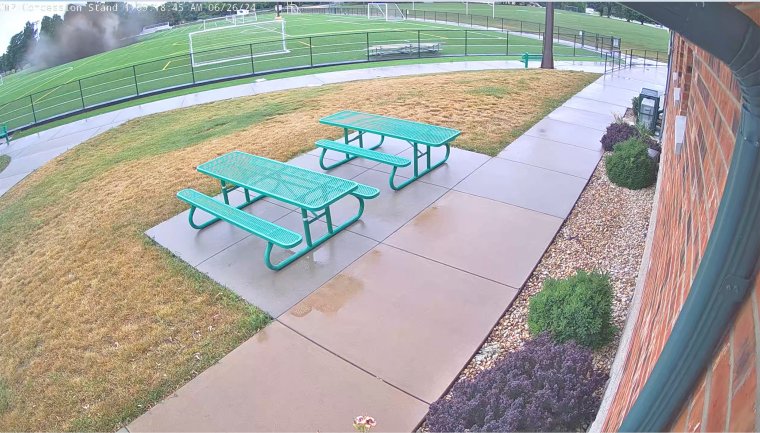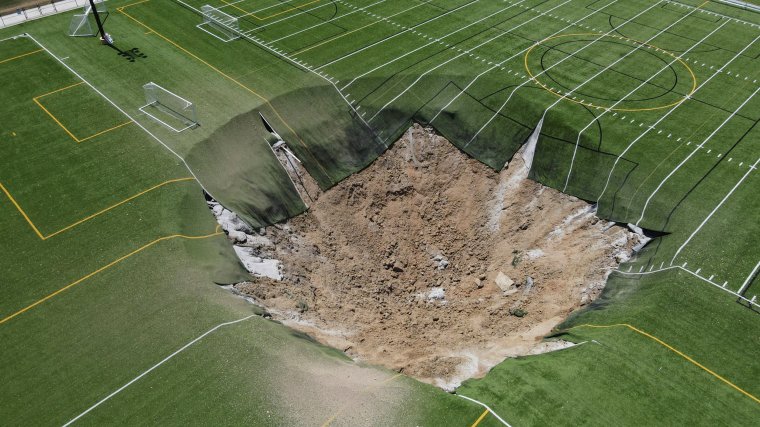A massive sinkhole opened up on a football field in southern Illinois on Wednesday, taking a light pole, benches and artificial turf down with it.
The hole, measuring at least 100ft wide (30.5m) and up to 50 ft deep (15m), is understood to have been caused by subsidence from underground limestone mining.
The moment was caught on a nearby security camera, showing an area between two football and American football fields opening up around the light pole at Gordon Moore Park.
What is a sinkhole?
According to the United States Geological Survey (USGS), a sinkhole is a depression in the ground that has no natural external surface drainage, meaning that when it rains, all the water stays inside the sinkhole and typically drains into the sub-surface.
“Sinkholes form when a cavity in the underground is collapsing in the surface,” Professor Jürgen Adam of Royal Holloway University explained.
“It has a thin roof with overlying sediment to the surface. When the roof is being weakened it can collapse and then the entire over burn sediments and rocks fall into the cavity,”
Sinkholes are most common in what geologists call “karst terrain” which are regions where the types of rock below the land surface can naturally be dissolved by groundwater circulating through them.
They are often saucer-shaped hollows, however they can appear in a variety of different shapes and settings depending on the composition of the rocks and different interacting processes.

What causes sinkholes?
The British Geological Survey (BGS) states that some sinkholes result from the removal of a soluble rock such as chalk, gypsum or limestone – named as solution sinkholes.
These rocks dissolve when attacked by rainfall or groundwater that is acidic.
Other sinkholes are anthropogenic in origin while some occur due to collapse of old, abandoned mines.
Although a natural process, the formation of sinkholes is often accelerated or triggered by human influences, such as broken drains, water mains and sewerage pipes, or modified drainage and diverted surface water; these wash sediment into the underlying materials, causing subsidence.
Sinkholes can occur rapidly and apparently without warning, meaning they can be dramatic because the land usually stays intact for a period of time until the underground spaces just get too big.
If there is not enough support for the land above the spaces, then a sudden collapse of the land surface can occur.
A spokesperson for BGS stated that, “As far as I can tell from press reports, this appears to be an anthropogenic collapse of a limestone mine, not a natural sinkhole due to dissolution.”
“The town of Alton, Illinois has a legacy of old limestone and coal mines, but it appears that this is collapse above an active mine. Surface collapses above active mine workings are rare but do occasionally occur.”

Can sinkholes occur in the UK?
“Sinkholes can happen everywhere if you have mining operations and mined limestones. If you are not very careful or if there’s an incident during mining operations or tunnelling, it can result in a sinkhole,” confirmed Dr Jürgen Adam.
“This is a risky incident and also causes quite a lot of economic damage. People need to take proper precautions.”
There are a number of soluble rocks across the UK that form karst.
These include Devonian and Carboniferous limestone, Permian and Triassic halite and gypsum, and Jurassic and Cretaceous limestones and chalk.
In the UK most sinkholes are relatively small or are in upland, rural locations such as the Mendips, parts of Wales, the Peak District and the northern Pennines, including the Yorkshire Dales.
The most susceptible area in the UK, according to the BGS, is north-east England, particularly around Ripon in North Yorkshire where there is a large amount of Permian gypsum deposits.
In Ripon, many large sinkholes have developed, some of which have affected property and infrastructure. This is due to the mineral gypsum being far more soluble than limestone, which means it dissolves more rapidly.
Sinkholes also occur over salt deposits, commonly in areas such as Cheshire where brine has been extracted, making it difficult to separate naturally formed sinkholes from those created by man.
The Chalk Group is also susceptible and surface lowering of the chalk is especially evident where it is covered by younger clay and sand deposits in parts of Dorset, Hampshire and the Chilterns in southern England.
In Scotland, sinkholes are generally rare except in parts of Assynt underlain by the Cambrian Durness Limestone, the BGS has said.

Grindr must act but there are darker reasons why children are on the dating app